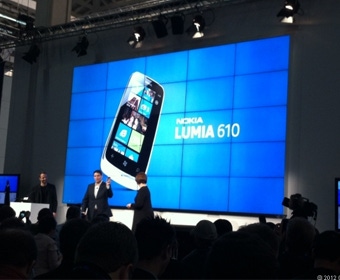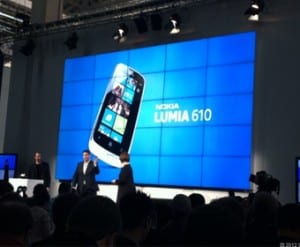Nokia has announced today two new smartphones powered by Microsoft Windows Phone 7 (WP7), the Lumia 610 and an LTE-less variant of Lumia 900 targeting Non-US market. With the introduction of these new smartphones, Nokia aims to broaden its WP7 portfolio beyond the main-stream smartphone market.
February 27, 2012

By Malik Saadi
Malik Saadi, Principal Analyst at Informa Telecoms & Media comments on Nokia’s Windows Phone 7 range.
 Nokia has announced today two new smartphones powered by Microsoft Windows Phone 7 (WP7), the Lumia 610 and an LTE-less variant of Lumia 900 targeting Non-US market. With the introduction of these new smartphones, Nokia aims to broaden its WP7 portfolio beyond the main-stream smartphone market. While the release of LTE-Less Lumia 900 has come with no surprise, the most impressive news in today’s announcement was the release of Lumia 610, the lowest BOM and lowest cost WP7 phone introduced so far. With a retail price of about 190 Euros, Nokia is now one step closer to bringing WP7 to the entry level smartphone segment.
Nokia has announced today two new smartphones powered by Microsoft Windows Phone 7 (WP7), the Lumia 610 and an LTE-less variant of Lumia 900 targeting Non-US market. With the introduction of these new smartphones, Nokia aims to broaden its WP7 portfolio beyond the main-stream smartphone market. While the release of LTE-Less Lumia 900 has come with no surprise, the most impressive news in today’s announcement was the release of Lumia 610, the lowest BOM and lowest cost WP7 phone introduced so far. With a retail price of about 190 Euros, Nokia is now one step closer to bringing WP7 to the entry level smartphone segment.
This news has come only a few months after the decision by Microsoft to relax hardware requirements for its mobile platform, which clearly shows strong dedication from the Finnish company to execute its WP7 strategy which was revealed just one year ago. This move will clearly enable Nokia to better compete in the low-cost smartphone market without compromising the device performance or the overall user-experience.
Dave McQueen, Principal Analyst at Informa Telecoms & Media comments on Nokia’s Asha range.
As a follow-up to the Asha range that Nokia unveiled at its yearly press event last October, the company has extended the 4-device range by 3, launching the 202, 203 and 302 at MWC. Running on Nokia’s home-grown Series 40 and further blurring the distinction between the featurephone and smartphone with a bundled array of content and service, the devices are all designed to encourage access to the web and the use of data services.
Although directed toward connecting the “next billion” of users in emerging markets, there is obvious value for pushing these “smartness” handsets into developed markets. As with others in the range, the new 202 includes an Easy Swap dual-SIM option and will be available for €60. By also announcing an expansion of Nokia Life and creating Mail for Exchange for some devices in the Asha range, the decision made by business users and consumers alike to reach blindly for an out-and-out smartphone is perhaps not an obvious choice as once was, particularly if
Andy Castonguay, Principal Analyst at Informa Telecoms & Media comments on Nokia’s new 808 PureView.
While most recent news about Nokia has focused on its growing portfolio of Windows Phone-based devices, Nokia will reveal some of the handiwork it has recently undertaken to refresh its Symbian line-up at Mobile World Congress. Nokia’s new 808 PureView model will highlight the company’s renewed focus on imaging. With a robust set of technology to enhance the device’s imaging capabilities, the 808 will be positioned as a flagship device in markets where Nokia has not yet launched its Lumia line of smartphones. With a Carl Zeiss, high resolution sensor and advanced oversampling algorithms, the device is capable of generating an image files equivalent to 41 megapixels. While most consumers won’t take advantage of the full oversampling capability, they will benefit from better low-light performance, high-speed shutter and on-the-fly editing capabilities.
Symbian sales have been eroding swiftly in recent quarters amid new competition and the expectations for the new Lumia portfolio, but in key markets such as India and China as well as markets in the Middle East and Africa, Nokia is hoping to leverage what remains of Symbian magic and enhanced imaging capabilities to hold on to their market share through the broader transition.
Read more about:
DiscussionYou May Also Like






.png?width=300&auto=webp&quality=80&disable=upscale)


_1.jpg?width=300&auto=webp&quality=80&disable=upscale)


.png?width=800&auto=webp&quality=80&disable=upscale)